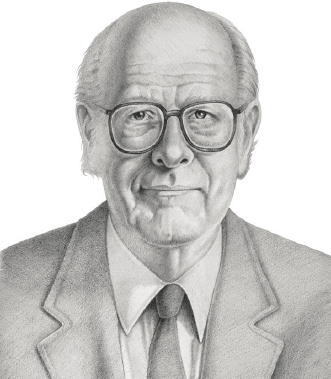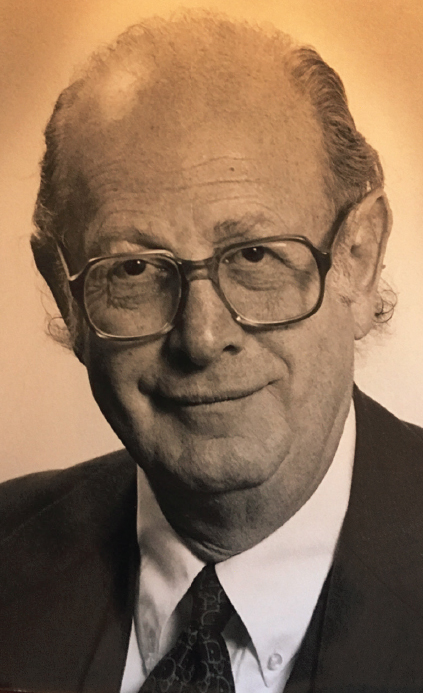

HOWARD RAIFFA
1924–2016
Elected in 2005
“For contributions to decision analysis, negotiation analysis, and engineering decision making.”
BY RALPH L. KEENEY
HOWARD RAIFFA, a pioneer in all aspects of the decision sciences, was an emeritus professor at both the Harvard Business School and the Harvard Kennedy School of Government. He passed away peacefully in his sleep at home in Tucson, Arizona, on July 8, 2016, at the age of 92.
He made substantial contributions to the decision sciences and the fields of systems analysis and operations research. His remarkable books have influenced countless individuals and organizations. He guided the introduction of the decision sciences into numerous fields, from business to medicine, public health, environmental sciences, and law.
With a brilliant mind and enormous personal charisma, his main professional interest was to help individuals, organizations, countries, and groups of countries make better decisions by using insights from better analyses. He was concerned with both theory and practice, because if theories are not used, they can have no influence.
Howard was born January 24, 1924, in New York City and grew up in the Bronx. He briefly attended the City College
Many interesting details of Howard’s life are discussed in his Memoir: Analytical Roots of a Decision Scientist (CreateSpace Independent Publishing Platform, 2011).
of New York and then joined the Army just before his 19th birthday. He was trained in the use of radar and served in air traffic control in the Pacific. After the war, he returned to the United States and in 1945 married Estelle Schwartz, his high school sweetheart. Soon after, they went to the University of Michigan, where Howard received his BS (1946) and PhD (1951) in mathematics and MS in statistics (1947) and Estelle got a teaching degree. Their son Mark was born in 1952 and their daughter Judith in 1955.
Howard’s first faculty position, in 1952, was at Columbia University, where he and Duncan Luce wrote Games and Decisions: Introduction and Critical Survey (John Wiley & Sons, 1957), which organized and communicated the concepts, results, and relevance of game theory to a wide audience, including social scientists and political analysts. This book is the classic source for the basic concepts and results of game theory, as well as the original foundation for decisions under uncertainty. Although deep in substance, it is accessible for many readers, a common feature of Howard’s publications.
In 1957 Howard accepted an appointment in the Harvard Business School, and went on to hold academic appointments in the Departments of Economics and Statistics, Kennedy School of Government, and Graduate School of Business. In addition, consistent with his often expressed interest in applying the decision sciences, he developed and taught courses on decision making in the schools of law, medicine, and public health, and for Harvard College undergraduates. He had approximately 90 doctoral students and helped thousands of students through his dedicated teaching and guidance. He retired as professor emeritus in 1994.
When he arrived in 1957 he began working with Robert Schlaifer and John Pratt in statistical decision theory. The resulting books, Applied Statistical Decision Theory (Harvard University, 1961) and Introduction to Statistical Decision Theory (McGraw-Hill, 1965), provided the foundations for Bayesian analysis of standard statistical problems, combining prior knowledge about problems with specific data gathered to lend operational insight for decisions. Applied Statistical Decision
Theory was republished in 2000 (Wiley) as a classic in mathematics and statistics.
The three also coauthored the article “The Foundations of Decision Under Certainty: An Elementary Exposition,”1 which jointly axiomatized utility and subjective probability to provide a practical basis for a prescriptive theory to guide decision making. Howard’s next book, Decision Analysis (Longman Higher Education Division, 1968), illustrated the operational use of these ideas and introduced many advanced topics such as risk sharing, group decisions, and multiple objectives.
In the mid-1960s Howard’s interest expanded from classes of problems focused on management and economics to problems relevant to the public domain, concerning government policy, science policy, public health, and clinical medicine. Such problems usually involve multiple objectives and their resolution requires the consideration of value trade-offs among the objectives.
Howard spent the summer of 1965 at the RAND Corporation developing a foundation for thinking about the analysis of problems with multiple objectives. He was my advisor when I completed my dissertation on the theory and application of multiple-attribute utility in 1969, and we coauthored Decisions with Multiple Objectives (John Wiley & Sons, 1976). The book provides the theory and procedures to expand the use of decision analysis to resolve complex decisions involving multiple objectives, and was selected for the ORSA Lanchester Prize for the best operations research publication in 1976.
A few years later Howard’s book The Art and Science of Negotiation (Harvard University Press, 1982) established the discipline of negotiation analysis. Until then, much of the knowledge about negotiations was basically art and folklore, with little structure or science. Howard developed the concepts and procedures that created negotiation analysis as a field with substance meriting serious study. This book brilliantly communicates and illustrates the simple message that analysis of negotiations can provide very useful insights for negotiators. It
___________________
1 Journal of the American Statistical Association 59(306):353–75, 1964.
also stresses the value of cooperative negotiations by explaining how all sides can better achieve their objectives through various cooperative strategies. It was awarded the 1985 Leo Melamed Prize of the University of Chicago Business School for the most significant published work by a faculty member in a school of business in the preceding 2 years. The book Negotiation Analysis (Belknap Press, 2002) integrates much of Howard’s earlier work and includes developments in negotiation analysis since 1982.
In 1995 Howard, John Hammond, and I decided to write a book to synthesize the fundamental ideas and procedures of decision analysis and communicate them in a manner that anyone facing important decisions could understand and use. Our goal was to broaden the use of the key tenets of good decision making. The result, Smart Choices (Harvard Business School Press, 1999), was awarded the annual publication prize of the Decision Analysis Society in 2001.
Beyond his teaching and prolific writing, Howard took a leading role in the formation of two significant institutions. In 1968–72 he participated in the negotiations that created the International Institute for Applied Systems Analysis (IIASA, located near Vienna), the first nongovernmental international research institute. The motivation for its establishment was to enable scientists from East and West to work together on problems of common concern, and it was sponsored by the national academies of science of 12 countries, including the United States and the former Soviet Union. IIASA came into existence on October 4, 1972, and Howard served as its first director (1972–75). The institute has flourished and today is sponsored by national scientific organizations of 24 countries. Howard’s leadership and legacy at IIASA are still very evident.
Howard was also instrumental in creating Harvard’s Kennedy School of Government. His original suggestion was “a school with its own faculty, primarily stressing a professional master’s program, with say 50% to 75% of its instruction by the case method, and with its own mini-campus.” He became part of a committee of four who designed the Kennedy School and are recognized as its founders. Howard
firmly believed that it was important to educate leaders and future leaders about the significant contributions of thoughtful analysis to make better decisions.
Howard’s intellectual and academic achievements were widely recognized. He was elected a member of the American Academy of Arts and Sciences (1972) and received the Distinguished Contribution Award of the Society of Risk Analysis (1984), Frank P. Ramsey Medal of the Decision Analysis Society (1985), Gold Medal of the International Society for Multiple Criteria Decision Making (1998), Carnegie Mellon University Dickson Prize in Science (2000), and INFORMS Saul Gass Expository Writing Award (2002). He was elected to the NAE in 2005. He also received honorary doctoral degrees from Carnegie Mellon University, the University of Michigan, Northwestern University, Ben-Gurion University of the Negev, and Harvard University.
Yet for all his accomplishments and honors, Howard had personal humility and was generous with his time and attentive to the ideas and concerns of others. He was clear thinking, unwaveringly considerate, ethical, fair, loyal, often humorous, ever positive, inspiring, and a wonderful colleague and friend.
Howard and Estelle celebrated their 70th wedding anniversary in 2015. She passed away in January 2017. They are survived by Mark (Ruth), Judith, and four grandchildren.






